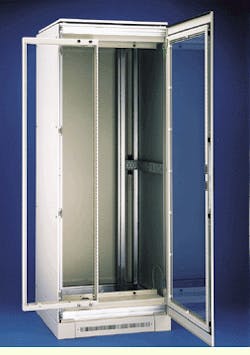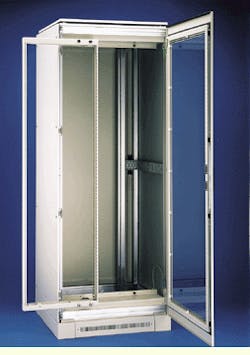Mark A. DeSorbo
There was a time that a rack was a rack. In fact, the only thing that really distinguished one from another was what the manufacturer called it, and in most cases, the word "rack" was in there somewhere.
Over the last few years, however, distribution and relay racks have evolved into an even more adaptable cable-management tool.
"It used to be a rack was a rack was a rack. It was just like when people said, `Cable is cable is cable,` " says Salvadore M. Lara, marketing coordinator for the ICC-Premise Wiring Div. (Cerritos, CA). "It ultimately came down to the need for versatility. Now that you have new options, that no longer holds true. Racks have more features and accessories that make installations and maintenance easier for the installer."
Frank Valleca, a product manager for The Siemon Co. (Watertown, CT), agrees. "There is an increased need for more and better cable management," he says. "More customers are using racks for mounting active equipment like routers, hubs, and servers, so they need heavy-duty racks."
Basic and more-enhanced models
Most manufacturers still make the basic stand-alone, 19-inch-wide distribution/relay rack, which is a solid base plate with two vertical frames that can be bolted to the floor. They also make more-enhanced models that incorporate swinging gates, vertical-hinged wall-mount brackets, cable hangers, hooks and loops, equipment shelves, and bolt holes to attach ladder racking. Racks come in different sizes: Some are 7 feet tall and others are more than 2 feet wide and 18 inches deep. Some come preassembled, many include a grounding kit, and others secure equipment from the rumblings of earthquakes (see Product Update table, page 66).
The innovations are mainly customer-driven says, Aaron Meunier, vice president of B&M Telecom Inc. (Mansfield, TX), a voice, data, audio, and video installer. "Not much has changed on the outside of racks," he says. "It`s the technology within the hardware that has been improved."
B&M handles a great deal of fiber-management and distribution jobs. Rack and fiber-optic-connector innovations, Meunier says, have allowed the firm to do more with less space in the closet. "When we got started in fiber optics, 3M was the predominant connector manufacturer. The connectors were basically biconic and bulky, and when the SC connector came along, that gave even better access in a rack," Meunier says. "With the SC connector, more fiber could fit into a smaller space, better access was provided, and trays within the rack are now easier to access as well as more protective."
Neatness counts
Another important part of a good installation, he adds, is neatness. "What we are mostly looking for in a rack is to store the slack for fiber-optic pigtails without it being a mess and still have enough room on the distribution panel to access one jumper without disturbing the others," Meunier says. "The evolution of the industry has allowed us to present a cleaner-looking and more-secure installation to the customer."
Hearing similar needs of installers, several manufacturers stepped up to meet concerns and built racks that make outfitting telecommunications closets easier. ICC has introduced three new racks this year, one of which is due out in August, Lara says, and will be marketed as an ICC cable-management rack.
"The cable-management rack is a little deeper, and cable rings mount to the front or the rear of the rack. They also can be rotated," he says. "Another unique feature is the base. Our engineers redesigned it to accommodate raised-floor configurations. The standard size for raised-floor tiles is 24 square inches. We designed the base to fit within the 24-inch square. Now, installers will not have to cut the floor tile to route the cable up."
The base has an elongated bolt hole instead of a straight round hole to adjust the placement of the rack. It also comes with a 6-inch cable channel along both sides to manage and conceal bulk cable vertically along the inside of the rack, while it has several cable-tie anchor points throughout the cable channel to secure cable bundles with Velcro straps.
ICC introduced a new swing-gate rack in July. The wall-mount design, Lara says, allows installers to swing equipment out once it is mounted on a rack, making wiring tasks easier. Cable-tie points and Velcro tie loops neatly organize cable throughout the rack, which has the capacity to hold 150 pounds of equipment. Punching down can be accomplished while the unit is completely opened.
More space and better use of it were exactly what Siemon had in mind when it designed the RS-07 and RS2-07, Velleca says. The RS series provides proper routing of both horizontal and backbone cabling as well as patch cords. Both racks have large vertical channels, and cable managers conceal and route large quantities of cable. "Rack-mount spacing has been optimized," he says. "Previously, vertical channels were only tapped on one side. Now, both sides are tapped so equipment and panels can be mounted on either the front or the back of the rack."
Siemon also manufactures a rack-top tray for the RS and RS2. The tray supports and manages cable bundles routed above the racks and eliminates the need for installing a ladder rack for routing cables. The tray is easily pressed into place without the use of tools or hardware and includes up to three separate cable paths featuring quarter-turn cable managers that can be relocated for maximum flexibility. Reusable hook-and-loop cable managers allow for quick and efficient cable additions or changes.
While many rack manufacturers have been rooted in the industry for years, there is one that was established just 19 months ago: innodata Ltd. (Derry, NH), owned and operated by Bob and Dee Laukonis.
"I worked for years selling photo-copy machines. Then, I worked for six years selling custom networking cables for Network Assemblies Corp. (nac--Salem, NH)," says Bob Laukonis. "Many of my customers asked me to find them some kind of shelf and bracket for small networks. After the 20th customer asked me for the same thing, I invented it with the patent-pending EZ-Mount Swivel Bracket."
Several distributors are selling innodata`s product, including Graybar, Anixter Inc., Anicom Inc., Wesco, and csc. The EZ-Mount Network Shelf provides shelf space for a hub, modem, or router and allows the installation of a 12- to 48-port patch panel and a power strip. Three months after the start of the company, Laukonis introduced another one of his inventions: the free-standing EZ-Mount Swivel Bracket, which was first integrated within the EZ-Mount Network Shelf. They allow for patch panels mounted on relay racks to be rotated 180o. "This provides a solid punch-down surface, and you don`t have to go around to the back of the rack," says Laukonis, the company`s vice president of sales. His wife, Dee, is company president.
Jerry Meier, product-development engineer for Sprint North Supply (New Century, KS), says he first saw Laukonis`s products at last winter`s bicsi conference and exhibition in Orlando, FL.
"Their booth was right across from ours, and I have never seen anything like this. After we saw it, we had to work with him," Meier says. "We have incorporated the shelf under Sprint Wiring Management System. It allows customers to install a small office application. It takes up very minimal space, and it doesn`t stick out like a relay rack."
According to Laukonis, the U.S. Coast Guard is using the EZ-Mount Network Shelf in its small networks, while the County of Osceola in Florida has already installed about 100 of these shelves within the school department.
Dennis Romero of CGQ, a contracting firm based in Glenwood Springs, CO, echoed Meier`s sentiment in a letter he wrote to Laukonis in May after seeing the EZ-Mount Network Shelf in May at Networld+Interop, in Las Vegas. "The EZ-Mount shelf system is the best solution I have seen to address the small network cabling problems of confined spaces," Romero wrote. "It`s the best thing I saw at the show."
Apparently, the brackets within the EZ-Mount Network Shelves and relay-rack mountings were not enough for Laukonis`s customers because they asked for more. They now wanted a wall-mount version of the swivel bracket that was first shown at last January`s bicsi show.
"They now asked for a small, 8-inch-deep shelf to be mounted above the wall swivel bracket. This will allow for a smaller shelf assembly when using mini or micro hubs," Laukonis says. The EZ-Mount Wall Swivel Bracket Shelf was introduced at Networld+ Interop.
And Laukonis`s customers are still making demands. This time, it`s an enclosure to protect a network and its electronics. "By July, I will have the EZ-Mount Secur-A-Shelf, which will allow a hub and patch panel to be under lock and key," he says. "Hey, I listen to people and give them what they ask for. That`s our whole philosophy. That`s our motto: `We listen.` "
The Miracle Rack from Knürr usa Inc. is a stand-alone unit rated to protect against seismic activity. The rack has a 180° 19-inch swing frame available in heights ranging from 47.2 to 86.6 inches.

